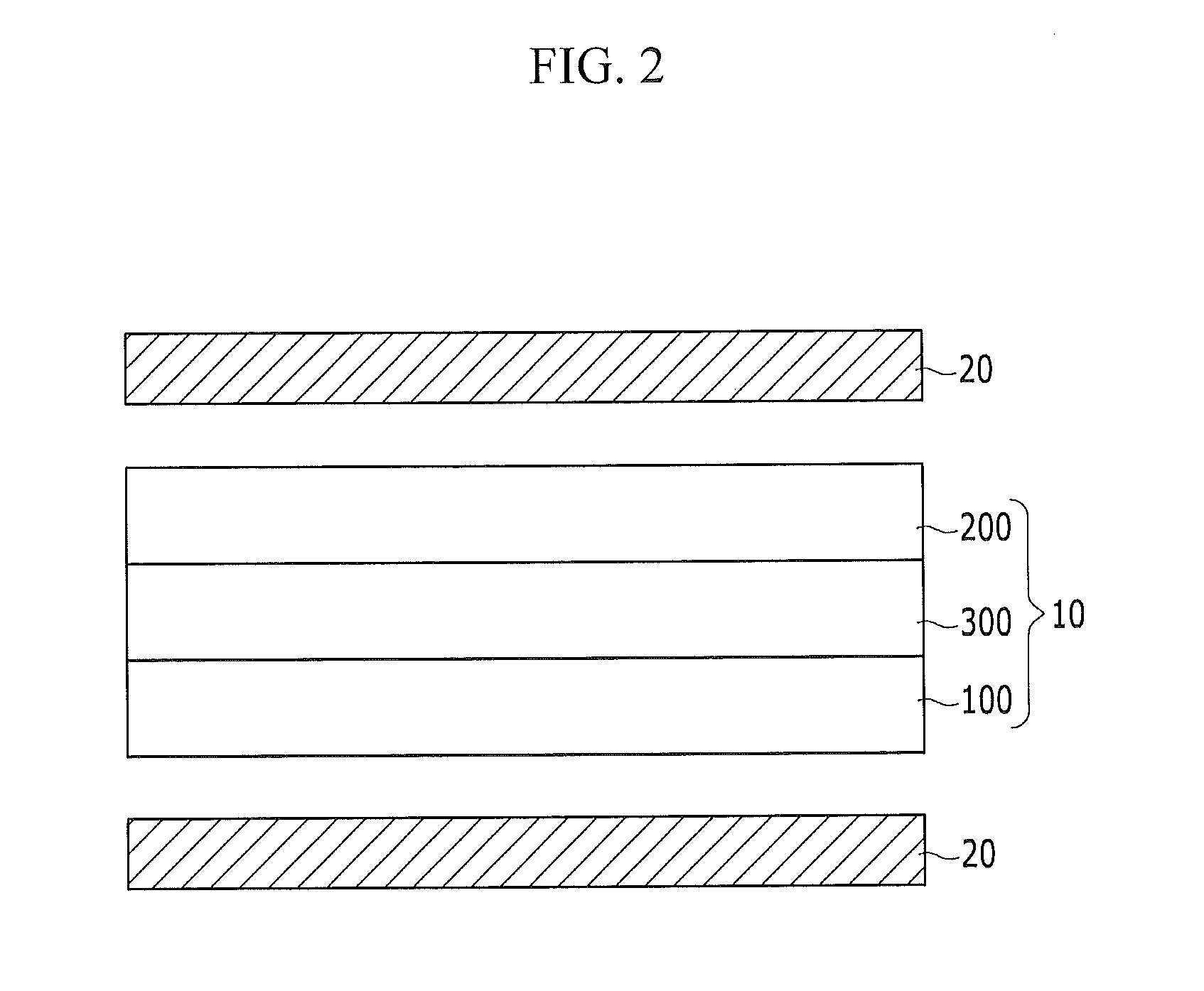Polarizing film and display device including the polarizing film
- Summary
- Abstract
- Description
- Claims
- Application Information
AI Technical Summary
Benefits of technology
Problems solved by technology
Method used
Image
Examples
synthesis example 1
1-1. Synthesis of Monoazo Compound
[0180]10 g (41.1 mmol) of 4-(4-nitrophenylazo)phenol (TCI, Japan) is dissolved in 200 mL of acetone, and 8.5 mL (48.9 mmol) of 1-bromooctane and 11.4 g (82.5 mmol) of potassium carbonate (K2CO3) are added thereto. The reaction mixture is refluxed and agitated at 60° C. for 24 hours and then cooled down to room temperature. The agitated mixture is concentrated and purified through silica gel column chromatography (CH2Cl2:n-hexane=2:1), obtaining 12.3 g (34.6 mmol) of a 4-nitro compound. The compound has a yield of 84%. 5.7 g (16.0 mmol) of the 4-nitro compound is dissolved in 150 mL of hot ethanol, and a solution prepared by dissolving 11.5 g (47.9 mmol) of Na2S.9H2O in hot ethanol and water is added thereto. The resulting mixture is agitated at 80° C. for 5 hours and cooled down to room temperature. Then, a precipitated crystal is filtered, washed several times with water, and dried, obtaining 4.3 g (13.2 mmol) of 4-amino-4′-octyloxyazobenzene. The ...
synthesis example 2
[0190]456 mg (0.71 mmol) of a dichroic dye represented by the following Chemical Formula 1 b is prepared according to the same method as Synthesis Example 1, except for using 3-chloroaniline instead of m-toluidine. The dichroic dye has a yield of 71%.
[0191]The dichroic dye represented by the above Chemical Formula 1 b is analyzed by 1H NMR (Brucker Co., 300 MHz).
[0192]The 1H NMR analysis result is as follows.
[0193]1H NMR (300 MHz, CDCl3) δ (ppm): 0.90 (t, J=6.7 Hz, 3H, CH3), 1.25-1.38 (m, 8H, CH2×4), 1.45-1.49 (m, 2H, CH2), 1.71-1.86 (m, 8H, CH2×4), 3.46-3.50 (m, 4H, NCH2×2), 4.06 (t, J=6.4 Hz, 2H, OCH2), 6.24 (d, J=4.8 Hz, 1H, ArH), 7.02 (d, J=9.0 Hz, 2H, ArH), 7.61-8.12 (m, 10H, ArH).
[0194]The dichroic dye represented by the above Chemical Formula 1 b has a solubility parameter of 22.5.
synthesis example 3
[0195]450 mg (0.7 mmol) of a dichroic dye represented by the following Chemical Formula 1c is prepared according to the same method as Synthesis Example 1, except for using 4-amino-2-chloro-4′-octyloxyazobenzene instead of 4-amino-4′-octyloxyazobenzene and aniline instead of m-toluidine. The dichroic dye has a yield of 70%.
[0196]The dichroic dye represented by the above Chemical Formula 1c is analyzed by 1H NMR.
[0197]The 1H NMR analysis result is as follows (Brucker Co., 300 MHz).
[0198]1H NMR (300 MHz, CDCl3) δ (ppm): 0.90 (t, J=6.7 Hz, 3H, CH3), 1.25-1.36 (m, 8H, CH2×4), 1.45-1.50 (m, 2H, CH2), 1.71-1.85 (m, 8H, CH2×4), 3.43-3.47 (m, 4H, NCH2×2), 4.06 (t, J=6.6 Hz, 2H, OCH2), 6.21 (d, J=4.7 Hz, 1H, ArH), 7.02 (d, J=9.0 Hz, 2H, ArH), 7.59-8.11 (m, 10H, ArH).
[0199]The dichroic dye represented by the above Chemical Formula 1c has a solubility parameter of 22.5.
PUM
| Property | Measurement | Unit |
|---|---|---|
| Temperature | aaaaa | aaaaa |
| Fraction | aaaaa | aaaaa |
| Percent by mass | aaaaa | aaaaa |
Abstract
Description
Claims
Application Information
 Login to View More
Login to View More - R&D
- Intellectual Property
- Life Sciences
- Materials
- Tech Scout
- Unparalleled Data Quality
- Higher Quality Content
- 60% Fewer Hallucinations
Browse by: Latest US Patents, China's latest patents, Technical Efficacy Thesaurus, Application Domain, Technology Topic, Popular Technical Reports.
© 2025 PatSnap. All rights reserved.Legal|Privacy policy|Modern Slavery Act Transparency Statement|Sitemap|About US| Contact US: help@patsnap.com



